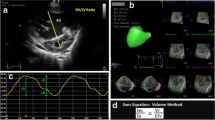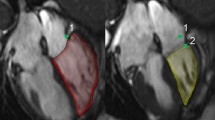Abstract
Right ventricular (RV) failure is a significant cause of morbidity and mortality in patients with pulmonary hypertension (PH). Myocardial performance index measured by tissue Doppler imaging (TDI-MPI) has been useful in assessing RV dysfunction in adults with PH. However, TDI-MPI as a marker for RV dysfunction or disease severity has not been evaluated in pediatric PH. The aim of this study was to investigate TDI-MPI and correlate with invasive hemodynamics in pediatric PH patients. Eighty pediatric PH patients undergoing cardiac catheterization and simultaneous transthoracic echocardiography were analyzed. RV TDI-MPI was averaged over three cardiac cycles and measured under each condition of vasodilatory testing during the catheterization. TDI-MPI was compared between PH patients and age-matched controls and correlated to invasive hemodynamics. RV TDI-MPI was increased in PH patients compared to controls (0.49 vs. 0.35, p < 0.0001). Significant associations (beta ± SE) are seen between RV TDI-MPI and baseline mean pulmonary arterial pressures (0.0002 ± 0.001, p < 0.05), indexed pulmonary vascular resistance (0.007 ± 0.002, p < 0.002), and pulmonary-to-systemic arterial pressure ratio (0.146 ± 0.063, p < 0.05). No statistically significant associations were seen with vasodilatory testing. RV TDI-MPI is elevated in children with PH, suggestive of RV dysfunction. RV TDI-MPI shows correlation with severity of PH at baseline but lacks sensitivity to evaluate the RV response to acute changes in afterload in children with PH. Therefore, while RV TDI-MPI can help identify RV dysfunction in children with PH, its utility as a non-invasive surrogate marker for acute changes in hemodynamics is limited.


Similar content being viewed by others
References
Ivy DD, Abman SH, Barst RJ et al (2013) Pediatric pulmonary hypertension. J Am Coll Cardiol 62:D117–D126. doi:10.1016/j.jacc.2013.10.028
Barst RJ, Ertel SI, Beghetti M, Ivy DD (2011) Pulmonary arterial hypertension: a comparison between children and adults. Eur Respir J 37:665–677. doi:10.1183/09031936.00056110
Jone P-N, Ivy DD (2014) Echocardiography in pediatric pulmonary hypertension. Front Pediatr 2:1–15. doi:10.3389/fped.2014.00124
Mourani PM, Sontag MK, Younoszai AK et al (2008) Clinical utility of echocardiography for the diagnosis and management of pulmonary vascular disease in young children with chronic lung disease. Pediatrics 121:317–325. doi:10.1542/peds.2007-1583
Kassem E, Humpl T, Friedberg MK (2013) Prognostic significance of 2-dimensional, M-mode, and Doppler echo indices of right ventricular function in children with pulmonary arterial hypertension. Am Hear J 165:1024–1031. doi:10.1016/j.ahj.2013.02.027
Friedberg MK, Redington AN (2014) Right versus left ventricular failure: differences, similarities, and interactions. Circulation 129:1033–1044. doi:10.1161/CIRCULATIONAHA.113.001375
Schaefer A, Meyer GP, Hilfiker-Kleiner D et al (2005) Evaluation of tissue Doppler Tei index for global left ventricular function in mice after myocardial infarction: comparison with Pulsed Doppler Tei index. Eur J Echocardiogr 6:367–375
Tei C, Ling L, Hodge D et al (1995) New index of combined systolic and diastolic myocardial performance: a simple and reproducible measure of cardiac function—a study in normals and dilated cardiomyopathy. J Cardiol 26:357–366
Tei C (1995) New non-invasive index for combined systolic and diastolic ventricular function. J Cardiol 26:135–136
Dyer KL, Pauliks LB, Das B et al (2006) Use of myocardial performance index in pediatric patients with idiopathic pulmonary arterial hypertension. J Am Soc Echocardiogr 19:21–27. doi:10.1016/j.echo.2005.07.010
Ogihara Y, Yamada N, Dohi K et al (2014) Utility of right ventricular Tei-index for assessing disease severity and determining response to treatment in patients with pulmonary arterial hypertension. J Cardiol 63:149–153. doi:10.1016/j.jjcc.2013.07.002
Grignola J, Gines F, Guzzo D (2006) Comparison of the Tei index with invasive measurements of right ventricular function. Int J Cardiol 113:25–33
Poulson S, Nielsen J, Anderson H (2000) The influence of heart rate on the Doppler-derived myocardial performance index. J Am Soc Echocardiogr 13:379–384
Rajagopalan N, Simon MA, Mathier MA, López-Candales A (2008) Identifying right ventricular dysfunction with tissue Doppler imaging in pulmonary hypertension. Int J Cardiol 128:359–363. doi:10.1016/j.ijcard.2007.06.094
Zimbarra CI, Ruisanchez C, Dawson D et al (2010) Right ventricular function in patients with pulmonary hypertension; the value of myocardial performance index measured by tissue Doppler imaging. Eur J Echocardiogr 11:719–724. doi:10.1093/ejechocard/jeq051
Bernus A, Wagner BD, Accurso F et al (2009) Brain natriuretic peptide levels in managing pediatric patients with pulmonary arterial hypertension. CHEST J 135:745–751. doi:10.1378/chest.08-0187.Brain
Gan CT, Mccann GP, Marcus JT et al (2006) NT-proBNP reflects right ventricular structure and function in pulmonary hypertension. Eur Respir J 28:1190–1194. doi:10.1183/09031936.00016006
Nagaya N, Nishikimi T, Uematsu M, Satoh T (2000) Plasma brain natriuretic peptide as a prognostic indicator. Circulation 102:865–870
Takatsuki S, Wagner BD, Ivy DD (2012) B-type natriuretic peptide and amino-terminal pro-B-type natriuretic peptide in pediatric patients with pulmonary arterial hypertension. Congenit Heart Dis 7:259–267. doi:10.1111/j.1747-0803.2011.00620.x.B-type
Abman SH, Hansmann G, Archer SL et al (2015) Pediatric pulmonary hypertension. Circulation 132:2037–2099. doi:10.1161/CIR.0000000000000329
Duan Y, Harada K, Wu W et al (2008) Correlation between right ventricular Tei index by tissue Doppler imaging and pulsed Doppler imaging in fetuses. Pediatr Cardiol 29:739–743. doi:10.1007/s00246-008-9215-2
Miller D, Farah MG, Liner A et al (2004) The relation between quantitative right ventricular ejection fraction and indices of tricuspid annular motion and myocardial performance. J Am Soc Echocardiogr 17:443–447
Tei C, Dujardin K, Hodge D et al (1996) Doppler echocardiographic index for assessment of global right ventricular function. J Am Soc Echocardiogr 9:838–847
Blanchard D, Malouf P, Gurudevan S et al (2009) Utility of right ventricular Tei index in the noninvasive evaluation of chronic thromboembolic pulmonary hypertension before and after pulmonary thromboendarterectomy. JACC Cardiovasc Imaging 2:143–149
Eidem BW, O’Leary PW, Tei C, Seward JB (2000) Usefulness of the myocardial performance index for assessing right ventricular function in congenital heart disease. Am J Cardiol 86:654–658
Guihaire J, Emmanuel P, Schrepfer S et al (2015) Advancing knowledge of right ventricular pathophysiology in chronic pressure overload: insights from experimental. Arch Cardiovasc Dis 108:519–529. doi:10.1016/j.acvd.2015.05.008
Sanz J, Nair A, Ferna L et al (2012) Right ventriculo-arterial coupling in pulmonary hypertension: a magnetic resonance study. Heart 98:238–244. doi:10.1136/heartjnl-2011-300462
Truong U, Patel S, Kheyfets V et al (2015) Non-invasive determination by cardiovascular magnetic resonance of right ventricular-vascular coupling in children and adolescents with pulmonary hypertension. J Cardiovasc Magn Reson 17:1–8. doi:10.1186/s12968-015-0186-1
Jone PN, Patel SS, Cassidy C, Ivy DD (2016) Three-dimensional echocardiography of right ventricular function correlates with severity of pediatric pulmonary hypertension. Congenital Heart Disease. doi:10.1111/chd.12337
Harada K, Tamura M, Toyono M, Yasuoka K (2002) Comparison of the right ventricular Tei index by tissue Doppler imaging to that obtained by pulsed Doppler in children without heart disease. Am J Cardiol 90:566–568
Funding
This study was supported by the Frederick and Margaret L. Weyerhaeuser Foundation, the Jayden de Luca Foundation, NIH Grants R01HL114753, U01HL121518, and by NIH/NCATS Colorado CTSA Grant Number UL1 TR001082.
Author information
Authors and Affiliations
Corresponding author
Ethics declarations
Conflict of interest
All authors declare they have no conflicts of interest to disclose.
Ethical Approval
All procedures performed in studies involving human participants were in accordance with the ethical standards of the institutional and/or national research committee and with the 1964 Helsinki declaration and its later amendments or comparable ethical standards.
Informed Consent
Informed consent was obtained from all individual participants included in the study.
Rights and permissions
About this article
Cite this article
Friesen, R.M., Schäfer, M., Burkett, D.A. et al. Right Ventricular Tissue Doppler Myocardial Performance Index in Children with Pulmonary Hypertension: Relation to Invasive Hemodynamics. Pediatr Cardiol 39, 98–104 (2018). https://doi.org/10.1007/s00246-017-1733-3
Received:
Accepted:
Published:
Issue Date:
DOI: https://doi.org/10.1007/s00246-017-1733-3




